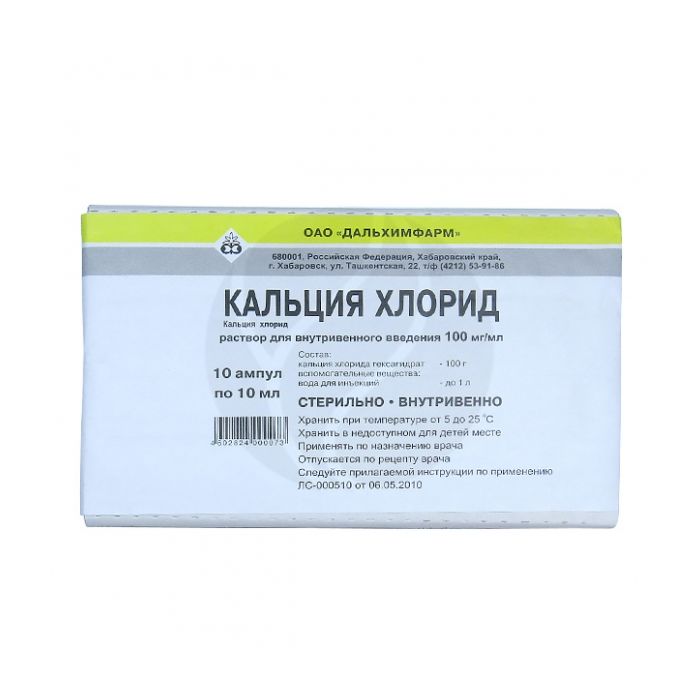Calcium chloride solution 10%, 10ml No. 10
Expiration Date: 05/2027
Russian Pharmacy name:
Кальция хлорид раствор 10%, 10мл №10
When administered intravenously, a single dose is 0.5-1 mg. When taken orally, a single dose is 0.25-1.5 g. The frequency and duration of use depend on the indications and the clinical situation.
calcium chloride 100 mg in 1 ml
Tendency to thrombosis, severe atherosclerosis, hypercalcemia.
pharmachologic effect
Calcium - a macronutrient involved in the formation of bone tissue, the process of blood coagulation, is necessary to maintain stable cardiac activity, processes of transmission of nerve impulses. Improves muscle contraction in muscular dystrophy, myasthenia gravis, reduces vascular permeability. With the on / in the introduction of calcium causes excitement of the sympathetic nervous system and increased adrenal secretion of adrenaline; has a moderate diuretic effect.
When a solution of calcium chloride interacts with magnesium salts, oxalic and fluoric acids, insoluble compounds are formed, which makes it possible to use a solution of calcium chloride as an antidote.
Indications of the active substances of the drug Calcium chloride
As an additional remedy in the treatment of allergic diseases (including serum sickness, urticaria, angioedema, hay fever) and allergic reactions to medications. As an additional hemostatic agent for pulmonary, gastrointestinal, nasal, uterine bleeding. As an antidote for poisoning with magnesium salts, oxalic acid and its soluble salts, as well as soluble salts of fluoric acid.
Dosage regimen
When administered intravenously, a single dose is 0.5-1 mg. When taken orally, a single dose is 0.25-1.5 g. The frequency and duration of use depend on the indications and the clinical situation.
Side effect
Possibly: bradycardia; with rapid introduction - ventricular fibrillation; with the on / in the introduction - a feeling of heat in the mouth, and then throughout the body.
Contraindications for use
Tendency to thrombosis, severe atherosclerosis, hypercalcemia.
special instructions
Do not enter p / c and i / m. When calcium chloride enters the skin or muscle tissue, severe irritation develops with the formation of foci of necrosis.
Drug interactions
Calcium chloride is incompatible with salts of lead, silver, monovalent mercury due to the formation of insoluble heavy metal chlorides and with sodium barbital, because in this case, a slightly soluble calcium salt of barbital is formed.
Calcium chloride, when used simultaneously, reduces the effect of calcium channel blockers. Under the influence of cholestyramine, the absorption of calcium from the gastrointestinal tract is reduced. With simultaneous use with quinidine, it is possible to slow down intraventricular conduction and increase the toxicity of quinidine. During treatment with cardiac glycosides, parenteral administration of calcium chloride is not recommended due to increased cardiotoxicity.

